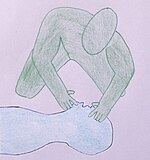First aid techniques
WARNING: This page has not been checked for conformance to current recommendations.
- Please help develop this resource, discuss status on the Talk page
First aid is the provision of initial care for an illness or injury. The first aid techniques here described include cardiopulmonary resuscitation (CPR), artificial respiration, treatment of bleedings and fractures. These techniques (in this order !) are the basic life support techniques a person should learn. They can be used in an emergency and can be used after a cardiac arrest or after an accident. They can be done by regular people after a short course and with (at least yearly) training. For the sake of remembrance, we use the mnemonic "PRBTF".
Pulse
[edit | edit source]

The first thing we do is to ensure that the person has a pulse. If this is the case, we will start on step 2. If it isn't the case, we begin step 5, ie the providing of cardiocerebral resuscitation. To provide cardiocerebral resuscitation:
- measure off 2 fingerwidths above the point where the ribs and the bottom of the sternum converge; put the palm of your left hand on this. Put your righthand on top of your left hand, and lock your fingers together. Start thrusting the sternum downwards (by 4-5cm). Provide 15 compressions (downward thrusts) with a speed of 80 per minute, followed by 2 artificial respirations. Continue the treatment untill the person's heart starts to beat, or upto one hour.[1][2]
Respiration
[edit | edit source]


First, lift up the head slightlty so that it falls backwards. This is to ensure that the tongue does not obstruct the airways. Then, open his/her mouth and check whether the person breathes and whether there are no obstructions in the airways. Then, pinch the nose closed, and exhale air into the person's lungs; the chest will come up, check whether it goes down again. Repeat this process a couple of times. Then, put the person in the stable side position by bending the right arm so that it touches the left shoulder, roll the person over, ensure that the right arm is below the head and bend the leg. The bending of arms and legs is necessairy to ensure that the person's head is positioned freely; this way if the person vomit's he can't sufficate.
- ==Bleedings==*
.......Bleeding is defined as the loss of blood.......
......The organ and the blood vessel contains blood , if any of these is damaged, blood can flow freely inside or outside the body.....,.. ......There are steps to take if you are faced with bleeding right now....... ........Don't remove the cloth.Add more layers if needed . The cloth will help clots from to stop the flow.......
Temperature
[edit | edit source]Check whether the person's body temperature is correct, if ie a person has been in a cold environment for too long, he may have hypothermia. After a stressful situation, the person can also be cold due to shock. For hypothermia, we must apply heat only to the torso, and not to the extremeties (ie arms, legs, ...) This is because if too much heat was lost, the adding of heat over the entire body can cause cardiac arrest. Therefore we must only heat the center of the body (which houses the primary blood circuit). Provide heat by providing a hot water bottle under the armpits, or fill up a tub with hot water and have the person enter it, keeping arms and legs outside of the water. After a stressfull situation (shock) we do not need to provide these measures, but only foresee a blanket.
Fractures
[edit | edit source]If the fracture is an open one and if you are skilled in this, place the bones correctly. Splint the broken bone(s).
